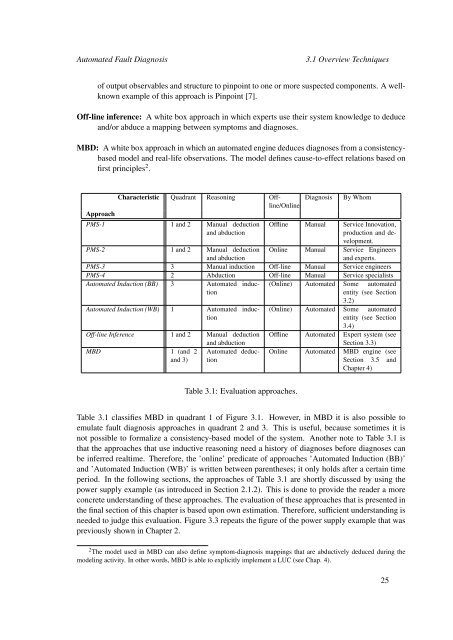pdf download - Software and Computer Technology - TU Delft
pdf download - Software and Computer Technology - TU Delft
pdf download - Software and Computer Technology - TU Delft
Create successful ePaper yourself
Turn your PDF publications into a flip-book with our unique Google optimized e-Paper software.
Automated Fault Diagnosis<br />
3.1 Overview Techniques<br />
of output observables <strong>and</strong> structure to pinpoint to one or more suspected components. A wellknown<br />
example of this approach is Pinpoint [7].<br />
Off-line inference: A white box approach in which experts use their system knowledge to deduce<br />
<strong>and</strong>/or abduce a mapping between symptoms <strong>and</strong> diagnoses.<br />
MBD: A white box approach in which an automated engine deduces diagnoses from a consistencybased<br />
model <strong>and</strong> real-life observations. The model defines cause-to-effect relations based on<br />
first principles 2 .<br />
Approach<br />
Characteristic Quadrant Reasoning Offline/Online<br />
PMS-1 1 <strong>and</strong> 2 Manual deduction<br />
<strong>and</strong> abduction<br />
Diagnosis<br />
By Whom<br />
Offline Manual Service Innovation,<br />
production <strong>and</strong> development.<br />
Online Manual Service Engineers<br />
<strong>and</strong> experts.<br />
PMS-2 1 <strong>and</strong> 2 Manual deduction<br />
<strong>and</strong> abduction<br />
PMS-3 3 Manual induction Off-line Manual Service engineers<br />
PMS-4 2 Abduction Off-line Manual Service specialists<br />
Automated Induction (BB) 3 Automated induction<br />
(Online) Automated Some automated<br />
entity (see<br />
Section<br />
Automated Induction (WB) 1 Automated induction<br />
Off-line Inference 1 <strong>and</strong> 2 Manual deduction<br />
<strong>and</strong> abduction<br />
MBD 1 (<strong>and</strong> 2 Automated deduction<br />
<strong>and</strong> 3)<br />
3.2)<br />
(Online) Automated Some automated<br />
entity (see Section<br />
3.4)<br />
Offline Automated Expert system (see<br />
Section 3.3)<br />
Online Automated MBD engine (see<br />
Section 3.5 <strong>and</strong><br />
Chapter 4)<br />
Table 3.1: Evaluation approaches.<br />
Table 3.1 classifies MBD in quadrant 1 of Figure 3.1. However, in MBD it is also possible to<br />
emulate fault diagnosis approaches in quadrant 2 <strong>and</strong> 3. This is useful, because sometimes it is<br />
not possible to formalize a consistency-based model of the system. Another note to Table 3.1 is<br />
that the approaches that use inductive reasoning need a history of diagnoses before diagnoses can<br />
be inferred realtime. Therefore, the ’online’ predicate of approaches ’Automated Induction (BB)’<br />
<strong>and</strong> ’Automated Induction (WB)’ is written between parentheses; it only holds after a certain time<br />
period. In the following sections, the approaches of Table 3.1 are shortly discussed by using the<br />
power supply example (as introduced in Section 2.1.2). This is done to provide the reader a more<br />
concrete underst<strong>and</strong>ing of these approaches. The evaluation of these approaches that is presented in<br />
the final section of this chapter is based upon own estimation. Therefore, sufficient underst<strong>and</strong>ing is<br />
needed to judge this evaluation. Figure 3.3 repeats the figure of the power supply example that was<br />
previously shown in Chapter 2.<br />
2 The model used in MBD can also define symptom-diagnosis mappings that are abductively deduced during the<br />
modeling activity. In other words, MBD is able to explicitly implement a LUC (see Chap. 4).<br />
25
















